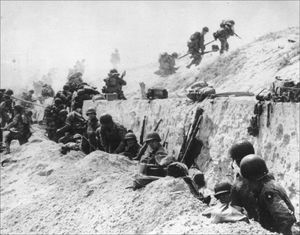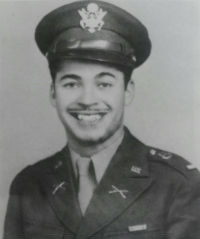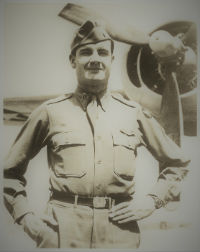Of the 16 million Americans who served in the military during the Second World War, more than 100 later served as U.S. senators. While the heroic actions of some of them are well known—John F. Kennedy leading the crew of PT-109, for example—what about the others who went on to serve as senators? Here are a few of their stories.
On June 6, 1944, more than 150,000 Allied troops landed along a 50-mile stretch of beach on the coast of Normandy, France. This extraordinary military operation marked the beginning of a strategic plan to liberate continental Europe from Nazi occupation. Philip Hart waded ashore at Utah Beach that day with the U.S. Army’s 4th Infantry Division. As he and his fellow soldiers advanced on fortified German targets, an artillery shell hit his right arm, severing the main artery. He slowed the bleeding with a hastily made tourniquet and insisted that medics attend first to a fallen comrade before consenting to his own evacuation. Hart was awarded the Bronze Star and the Purple Heart. He later served 17 years in the Senate, from 1959 to 1976, representing the state of Michigan.

Miles east of Hart’s location, Lee Metcalf, a commissioned officer with the army’s 5th Division, stormed Omaha Beach. Two thousand Americans died in a single day in a battle that came to be known as Bloody Omaha. American journalist Ernie Pyle later confessed what many thought at the time: “It seemed to me a pure miracle that we ever took the beach at all.” After Omaha, Metcalf helped to liberate Paris and fought in the Battle of the Bulge. Discharged in 1946, he returned to his home state of Montana, where voters elected him to four terms in the House of Representatives, followed by three terms in the Senate, from 1961 to 1978.
While Allied forces took Normandy beaches, James Strom Thurmond crash landed miles inland at an apple orchard near Sainte-Mère-Église, France, as part of the U.S. Army’s 82nd Airborne Division. Thurmond sustained minor injuries, spent the next few days in combat, and later helped to organize local provisional governments. He was awarded the Legion of Merit with Oak Leaf Cluster, the Bronze Star with Valor device, and the Purple Heart. The native South Carolinian represented his state in the Senate from 1955 to 2003.

Other future senators also fought with distinction. Shortly after the Japanese attack on Pearl Harbor, Edward Brooke, a former ROTC cadet and recent graduate of Howard University, was assigned to the U.S. Army’s segregated 366th Combat Infantry Regiment. In addition to the hazards of combat, Brooke encountered daily reminders of the second-class status given to African American soldiers who fought bravely in the European theater while facing intimidation and even violence from military officials. The U.S. military barred black soldiers from the PX and officers’ clubs and granted them access to the base movie theaters only at designated times. Later promoted to captain, Brooke earned the Bronze Star and a Distinguished Service Medal. Brooke represented the state of Massachusetts in the Senate from 1967 to 1979.

Throughout the war, American air power offered crucial support to Allied ground forces. Army Air Corps Lieutenant George McGovern flew a B-24 bomber on 35 missions over wartime Europe and never lost a man on his crew. The army awarded him the Distinguished Flying Cross in recognition of his “high degree of courage and piloting skill … intrepid spirit … and rare devotion to duty.” He later served three Senate terms for the state of South Dakota, from 1963 to 1981, and was the 1972 Democratic presidential nominee.
In the spring of 1945, the U.S. Army’s 10th Mountain Division began an offensive to gain control of northern Italy. Robert Dole, a combat infantry officer in the division, was critically wounded while leading his platoon on a mission to neutralize a pocket of German resisters holed up in a farmhouse. Dole spent nine agonizing hours on the battlefield awaiting his medical evacuation. The army awarded the future senator two Purple Hearts and the Bronze Star with Valor device for his leadership and courage under fire. Dole represented Kansas in the Senate for 27 years, from 1969 to 1996, and won the Republican presidential nomination in 1996.
That same month, another future senator fought in the Italian countryside. When the U.S. military dropped its enlistment ban on Japanese Americans in 1943, Daniel Inouye joined the U.S. Army’s segregated all-Nisei 442nd Regimental Combat Team. On a Tuscan battlefield in April 1945, Inouye was shot in the stomach while leading a flanking maneuver. He refused medical treatment and then organized a second attack. That’s when a German rifle grenade nearly severed his arm. Doctors later amputated it. For Inouye’s effort and perseverance, the Army awarded him the Bronze Star, the Purple Heart, and the Distinguished Service Cross. Later, while recuperating in a Michigan hospital, he befriended Philip Hart and Robert Dole, both of whom were recovering from their own injuries in the same hospital. Inouye represented the state of Hawaii in the Senate for 49 years, from 1963 to 2012.
These men, and more than 100 other veterans of the Second World War, shaped the Senate for decades to come. In 2013 the Senate’s last World War II veteran, Frank Lautenberg of New Jersey, died in office. Each year, as we commemorate D-Day on June 6, the war memorials that dot the coastline of Normandy serve as reminders of the sacrifices made by Allied forces during World War II, including the future senators who served in so many theaters of war. “We are duty bound to keep [their memory],” the Omaha Beach Museum states simply, “that future generations may never forget at what cost our freedom came.”